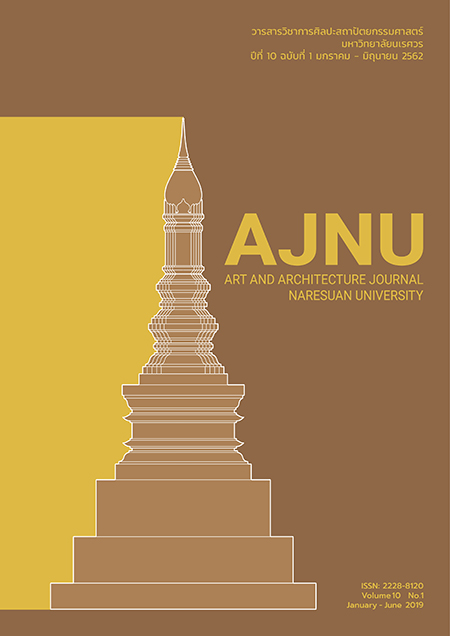The study of Ban Chiang Pottery Pattern Stamp for Creative Wickerwork Development ofNong Han Community UdonThani Province
Main Article Content
Abstract
This research aims to 1) studying the Ban Chiang pottery pattern stamp for analysis and a new pattern design apply to wickerwork pattern 2) integrating Ban Chiang pottery pattern stamp conduce into the household appliance product design and 3) evaluating the result of design whereas the research methodology by interviewing a design guideline from 4 experts in product design field and evaluating a prototype satisfaction by 300 consumers. The results found Ban Chiang pottery pattern could be classified in 3 patterns; 1) stripes pattern 2) geometric pattern and 3) nature pattern, and the pattern could create a new wickerwork style was a nature pattern, namely; leaf flower (Sacred fig leaf pattern) with the prosperity and the representative of Buddha as well as the buffalo pattern as the animal that conveyed to the abundance as well as being together with farmers The producers could consider about the possibility of production, raw material could be easy find out in local area, product size have been appropriate for distribute at OTOP booth, if there is a large production such as a chair, a lamp and a partition, that would affect for distribute area and shipping, consequently, the decoration items that the most appropriate should be the small items such as the decoration items on dining table. The evaluation result of the bamboo basket (buffalo pattern) could be conclusion that, the beauty and ability convey to the characteristic was a highest level (average 4.75), the table set of Catathea wickerwork (Sacred fig leaf pattern) could be conclusion that the beauty and ability convey to the characteristic was a highest level (average 4.70), the satisfaction of product prototype of home decoration overall was a high level (average 4.29).
Article Details
References
กนิษฐา เรืองวรรณศักดิ์. (2558). คู่มือ การนำองค์ความรู้ลูกกลิ้งและตราประทับดินเผาบ้านเชียง : ลวดลาย สู่งานออกแบบผลิตภัณฑ์. อุดรธานี : โรงพิมพ์บ้านเหล่า.
คำภูเพชร วานิชวงศ์ และศักดิ์ชาย สิกขา. (2553). การศึกษาศิลปะ “ฮูป”ฝาผนังในเขตพื้นที่แขวงหลวงพระบาง สปป.ลาว เพื่อประยุกต์ใช้ในการออกแบบและพัฒนาผลิตภัณฑ์ ประเภทของที่ระลึก. วารสารศิลปกรรมบูรพา.13(1), 21-31.
นัฐท์ธีรนนช์ รอดชื่น. (2560). การออกแบบผลิตภัณฑ์จักสานไม้ไผ่โดยใช้ภูมปัญญาท้องถิ่น วิสาหกิจชุมชนกลุ่มหัตถกรรมจักสานพื้นบ้าน บ้านดงชะพลู ตำบลบางมะฝ่อ อำเภอโกรกพระ จังหวัดนครสวรรค์. วารสารวิชาการ AJNU ศิลปะสถาปัตยกรรมศาสตร์มหาวิทยาลัยนเรศวร. 8(1), 12-23.
พิพิธภัณฑสถานแห่งชาติบ้านเชียง. (2555). เอกสารคลังพิพิธภัณฑสถานแห่งชาติบ้านเชียงประจำปี 2518- 2554. อุดรธานี : พิพิธภัณฑสถานแห่งชาติบ้านเชียง.
พิพิธภัณฑสถานแห่งชาติบ้านเชียง. (2557). ลูกกลิ้งและตราประทับดินเผาบ้านเชียง. อุดรธานี : พิพิธภัณฑสถานแห่งชาติบ้านเชียง. โบราณวัตถุจัดแสดง.
พิพิธภัณฑสถานแห่งชาติบ้านเชียง. (2558). มรดกศิลป์คืนถิ่นมาตุภูมิ. อุดรธานี : พิพิธภัณฑสถานแห่งชาติบ้านเชียง. นิทรรศการหมุนเวียน วันที่ 2 เมษายน - 31 กรกฎาคม 2558.
พิสิฐ เจริญวงศ์. (2530). มรดกบ้านเชียง.กรุงเทพฯ : มหาวิทยาลัยศิลปากร.
ภัทราพร ตั๊นงา. (2557). มรดกไทยคืนถิ่น! สหรัฐฯ มอบโบราณวัตถุสมัยก่อนประวัติศาสตร์ 554 ชิ้น คืนไทย / กรมศิลปากร จ่อทำทะเบียน และจัดแสดงบ้านเชียง. สืบค้นเมื่อ 19 พฤศจิกายน 2557, จาก https://patnews.wordpress.com/2014/11/19/.
วิบูลย์ ลี้สุวรรณ. (2531).ผ้าไทย. กรุงเทพฯ : องค์การค้าของคุรุสภา.
สุจิตต์ วงษ์เทศ. (2530). ศิลปวัฒนธรรมฉบับพิเศษ “บ้านเชียง”. กรุงเทพฯ : สำนักศิลปวัฒนธรรม.
อัษฎางค์ รอไธสง และคณะ. (2559). การศึกษาและพัฒนาผลิตภัณฑ์ลวดลายเฉพาะถิ่นงานทอเสื่อกก กลุ่มพนมรุ้งเสื่อกกและหัตถกรรม อำเภอเฉลิมพระเกียรติ จังหวัดบุรีรมย์. วารสารวิชาการ AJNU ศิลปะสถาปัตยกรรมศาสตร์มหาวิทยาลัยนเรศวร. 7(2), 147-157.
Armand J. Labbe. (2002). BAN CHIANG Art and Prehistory of Northeast Thailand. Tustin, CA : Smith Printers and Lithographers.
Joyce C. White. (1952). Discovery of a Lost Bronze Age BAN CHIANG. Philadephia, PA : University of Pennsylvania Press.

